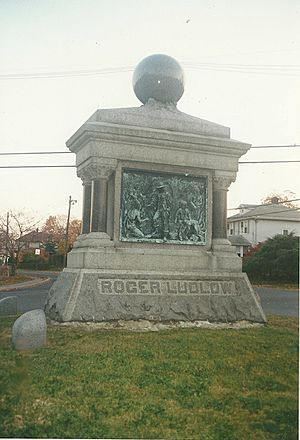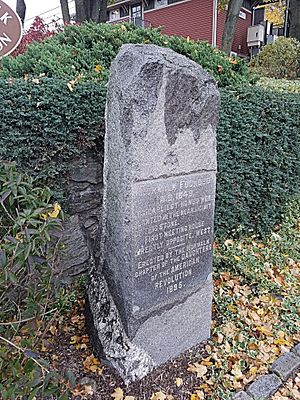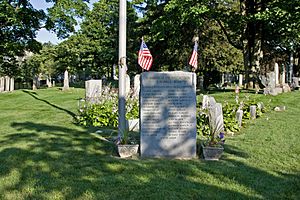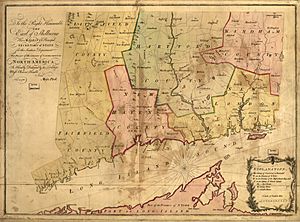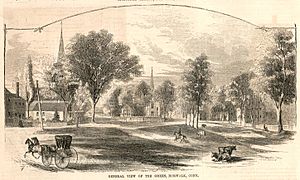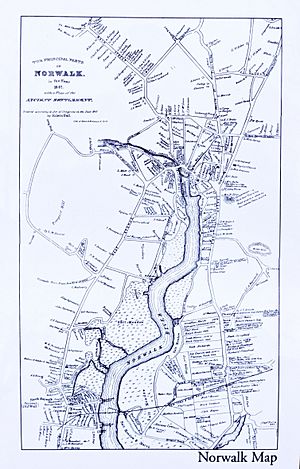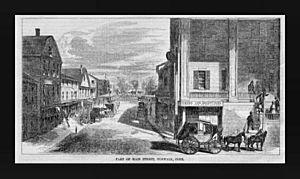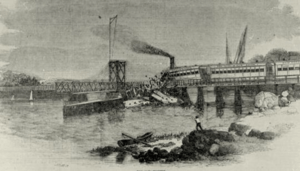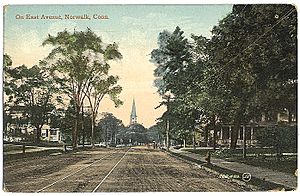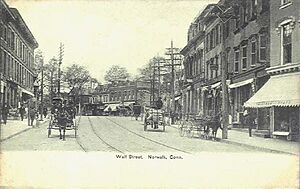History of Norwalk, Connecticut facts for kids
The history of Norwalk, Connecticut tells the story of this interesting city, from its earliest inhabitants to today. It covers how Native Americans lived here, how Europeans settled the area, and how Norwalk grew into the city it is now.
Contents
How Many People Lived in Norwalk?
| Census History | ||||||||||||||||||||||||||||||||||||||||||||||||||||||||||||||||||||||||||||||||||||||
|---|---|---|---|---|---|---|---|---|---|---|---|---|---|---|---|---|---|---|---|---|---|---|---|---|---|---|---|---|---|---|---|---|---|---|---|---|---|---|---|---|---|---|---|---|---|---|---|---|---|---|---|---|---|---|---|---|---|---|---|---|---|---|---|---|---|---|---|---|---|---|---|---|---|---|---|---|---|---|---|---|---|---|---|---|---|---|
|
|
|
||||||||||||||||||||||||||||||||||||||||||||||||||||||||||||||||||||||||||||||||||||
Early Inhabitants: Before Europeans Arrived
Long before Europeans came to the New World, Native Americans lived in the area we now call Norwalk, Connecticut. Many different groups of indigenous people came and went over thousands of years. They hunted, gathered food, and lived off the land.
Archaeologists have found tools and other items left behind by these early peoples. Some of these artifacts are from the Paleoindian Period, which dates back 5,000 to 10,200 years ago. These finds show that hunter-gatherers lived here a very long time ago.
Discovering Ancient Sites in Norwalk
Archaeologists have found evidence of ancient Native American life in three main areas of modern-day Norwalk.
Bitter Rock Shelter: A Glimpse into the Past
One important site is an ancient rock shelter called Bitter Rock. It was discovered and studied by archaeologists. They found undisturbed materials from early Native American cultures. This site is on private land near Ward Street, in an area once known as Winnupuck Village.
Spruce Swamp Pond: A Changing Environment
Another site, Spruce Swamp Pond, was first used by Native Americans about 3,000 years ago. Early residents were mostly hunters, based on the projectile points found there. Later, they also ate shellfish. The area changed when Long Island Sound moved inland, making Spruce Swamp salty. The site was then left empty between 1000 B.C. and 1500 A.D.
Today, Spruce Swamp is a small saltwater pond. It was much larger, about 7 acres, before it was changed by road construction in the 1930s and dredging in 1958. Even so, it remains an important archaeological site. Arrow points, pottery, and bone fragments have been found here.
Sasqua Hill: A Long-Used Campsite
The third site, Sasqua Hill, is about a mile northeast of Spruce Swamp. People lived here for several thousand years. It was first explored in 1962 as a "midden and campsite area with burials." A midden is a fancy word for an ancient trash heap, full of shells and bones. The site was estimated to be about 10,500 feet long. It was excavated again in 1965. Today, much of this area is a residential neighborhood, so any remaining parts of the site may have been destroyed.
An Ancient Pot Discovery
A pot made by Native Americans about 3,000 years ago was found in Norwalk. This pot shows how long people have lived in the area. A local resident, John Stumpf Sr., saved the pot after finding it in a curio shop. He later donated it to The Norwalk Museum, preserving this piece of history.
The 17th Century: European Settlement Begins
Norwalk's recorded history of settlement began in 1640. In 1614, a Dutch explorer named Adrian Block sailed past the Norwalk coast. He called the islands "The Archipelago." Later, in 1638, important Connecticut colonists met with the Native American owners of the land near "Narwoke."
Buying the Land: Norwalk's Purchase

Norwalk was bought in two separate deals in 1640 and 1641. Daniel Patrick bought the land west of the Norwalk River (which includes parts of South Norwalk, Rowayton, and West Norwalk) on April 20, 1640. Roger Ludlow bought the land east of the Norwalk River (including East Norwalk and Saugatuck) on February 26, 1641. Some old records might say 1640 for Ludlow's purchase because of a different calendar used back then.
Daniel Patrick came from Massachusetts and fought in the Pequot War. He bought land from the Norwake and Makentouh Indians. Roger Ludlow bought his land from Chief Mahackemo of the Norwalke Indians. These Native Americans were part of the Siwanoy group, who spoke an Algonquian language.
Who Were the Norwalk Native Americans?
The Native Americans living in Norwalk were often small groups, or "remnants of tribes." Evidence suggests different groups lived here, as shown by various artifacts and burial styles. One village of Mohegans was located at Belden's or Wilson's Point, called Naramake. The name Norwalk comes from this word, not from "Northwalk." This village was the home of Chief Mahackemo, who signed the land deeds.
In 2018, archaeologists found a centuries-old Native American fort during a rail-bridge project. This fort contained thousands of artifacts. These finds are helping historians understand more about the daily lives of Norwalk Indians and their trade with other groups.
Settling Down: Norwalk's First Homes
The Founder's Stone Monument marks the spot of Norwalk's earliest settlement and first Meeting House (where the government met). It says: "Norwalk founded A.D. 1649. Its earliest homes were planted in the near vicinity of this stone. First meeting house directly opposite west. Erected by the Norwalk chapter of the Daughters of the American Revolution 1895."
The first church, a Congregational church, was built by 1652. Its first minister was Thomas Hanford.
The first two settlers, Richard Olmsted and Nathaniel Ely, arrived from Hartford in 1649. Fourteen more followed them. Norwalk officially became a town on September 11, 1651, when the General Court said "Norwaukee shall bee a townee."
The First Settlers Monument in the East Norwalk Historical Cemetery lists many of these early families.
The settlers were farmers. They grew corn, then wheat, rye, oats, and barley. They raised cows for milk, and Calf Pasture Beach was used for grazing cows as early as the 1650s. They also grew flax and hemp to make linen and rope. Flax became an important export to the British Isles. Flax Hill Road today reminds us of this early crop.
The 18th Century: Growth and Revolution
St. Paul's Parish, an Episcopal church, was started in 1737. It is now known as St. Paul's on the Green.
Yankee Doodle: A Norwalk Connection
Connecticut's state song, Yankee Doodle, has ties to Norwalk! During the French and Indian War, a group of Norwalk soldiers joined British troops. Their commander was Col. Thomas Fitch, V of Norwalk, whose father was Connecticut's governor.
When the Norwalk men gathered, they didn't have uniforms. So, young local women, including Fitch's sister Elizabeth, gave them plumes made from chicken feathers for their hats.
When they arrived at Fort Crailo, New York, the British soldiers made fun of the Norwalk troops for their simple outfits and chicken feathers. A British army surgeon, Dr. Richard Shuckburgh, added new words to a popular song called Lucy Locket. He wrote the line, "stuck a feather in his cap and called it macaroni." "Macaroni" was slang for a fancy, foppish person. This is how the song "Yankee Doodle" began!
Today, the bridge where I-95 crosses the Norwalk River is named the Yankee Doodle Bridge. Col. Thomas Fitch V later helped rebuild Norwalk after the Revolutionary War. He is buried in the East Norwalk Historical Cemetery.
The Revolutionary War: Norwalk's Role
In 1776, American spy Nathan Hale left Norwalk by ship on his secret mission to Huntington, New York.
On April 25, 1777, British forces landed near what is now Westport's Compo Beach. As they marched to Danbury, American Patriots gathered their forces.
Norwalkers also carried out a daring raid in November 1778. Twenty whaleboats from Norwalk slipped past British warships in Huntington Bay. They captured sixteen British loyalists (Tories) and killed several others before leaving.
In 1779, British forces wanted to stop American naval activity in Long Island Sound. General William Tryon was ordered to attack the seaports of New Haven, Fairfield, and Norwalk. New Haven was raided on July 5, and Fairfield was burned on July 7. Knowing what was coming, Norwalk residents prepared for defense, many hiding in the hills known as "The Rocks."
The Battle of Norwalk was a fight between the Thirteen Colonies and Great Britain during the American Revolutionary War. British forces, led by Major General William Tryon, arrived on July 10, 1779. This attack was part of a series of raids on Connecticut coastal towns, known as Tryon's raid.
After the war, many Norwalk residents who lost their homes were given free land in the Connecticut Western Reserve in what is now Ohio. This is why there is a Norwalk, Ohio today.
The 19th Century: Industry and Innovation
In 1836, the central area of Norwalk around Wall Street and the Green became the Borough of Norwalk.
Railroads Arrive in Norwalk
In January 1849, the New York and New Haven Railroad began running trains through Norwalk. In 1852, the Danbury and Norwalk Railroad connected Norwalk with Danbury. The South Norwalk station was used by both lines.
The first major U.S. railroad bridge disaster happened in Norwalk in 1853. The engineer, Edward Tucker, didn't see that the drawbridge over the Norwalk River was open.
He couldn't stop the train in time, and the locomotive and several passenger cars plunged into the river. Forty-six people died, and about thirty were injured.
The Underground Railroad
Norwalk is believed to have been a stop on the Underground Railroad, a secret network that helped enslaved people escape to freedom in the North. Several routes from New York City passed through towns like Greenwich, Darien, Norwalk, and Wilton. Some old houses in Norwalk still have hidden rooms or passages that could have been used to hide runaways. While there's no official proof for specific houses, tradition says a house at 69 East Avenue was Norwalk's stop.
Oyster Cultivation: A Key Industry
Oyster farming has been a major industry in Norwalk for a long time. Native Americans taught the first settlers about the natural oyster beds off Norwalk's shores. A Norwalk oysterman, Captain Peter Decker, was the first to use steam power for oyster dredging in 1874.
Although too much fishing caused the industry to decline, it has been making a comeback since the late 1900s. However, oyster diseases like Dermo and MSX are still a challenge.
In 1871, the area known as Old Well was officially named the City of South Norwalk. In 1893, the Borough of Norwalk became the City of Norwalk. Both cities were part of the larger Town of Norwalk.
The 20th Century: Modern Norwalk Takes Shape
In 1913, the cities of Norwalk and South Norwalk, the East Norwalk Fire District, and the rest of the Town of Norwalk joined together to form the single City of Norwalk we know today.
The former city hall building was constructed in 1912.
In 1921, the Connecticut General Assembly divided the city of Norwalk into six taxing districts, with Rowayton becoming the sixth district.

The Red Scare and Norwalk
In 1954, Norwalk was in the news during a time called the "Red Scare." This was when many people were worried about communism in the United States. A local Veterans of Foreign Wars group in Norwalk announced they were giving names of residents they thought were "Communistic" to the FBI.
This caused a big debate across the country. Some people supported the VFW, while others said it violated people's rights. Even President Dwight D. Eisenhower commented on the situation. It turned out that the VFW post had not done a full investigation, and the story about a special committee was not true. The incident was particularly awkward because Norwalk was hosting newspaper reporters from NATO countries at the time, who were visiting a "typical American town."
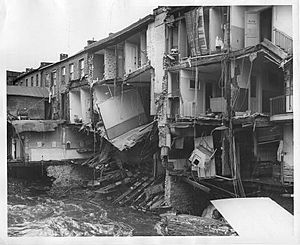
The Great Flood of 1955
In October 1955, a severe tropical storm brought 12-14 inches of rain to Connecticut. The Norwalk River flooded badly, and some dams broke, sending huge amounts of water downstream. Bridges and more dams were destroyed. Several lives were lost, and millions of dollars in damage occurred along the Norwalk River watershed.
Norwalk's downtown area, where the river meets the Norwalk Harbor, was hit especially hard. It took a long time for the area to recover.
Revitalizing South Norwalk (SoNo)
In the mid-1970s, the city government and local groups started the South Norwalk Revitalization Project. Their goal was to save the historic buildings in South Norwalk ("SoNo") and bring new life to the neighborhood, especially on Washington Street. The Washington Street National Historic District was created, and 32 buildings were added to the National Register of Historic Places.
To boost business, they decided to build an aquarium focused on Long Island Sound. This would be a tourist attraction. In 1986, construction began on the site of an old iron works factory. The aquarium, first called the Maritime Center at Norwalk, opened in 1988. It included an IMAX movie theater and a boat collection. In 1996, it was renamed the Maritime Aquarium at Norwalk.
The 21st Century: Norwalk Today
On Sunday, May 25, 2008, the last service was held at the First United Methodist Church of Norwalk. This marked the end of the church's use of its distinctive yellow brick building. The Methodist congregation began in 1789, but three other Methodist churches still exist in the city.
Images for kids


